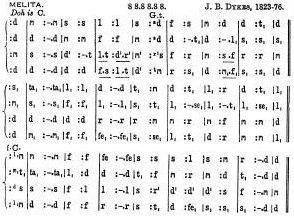Charlotte Mason advocated the use of the Tonic Sol-fa method of singing instruction. This system had been around since the early 1800s, but in the 1840s the Reverend John Curwen adapted it and turned it into a distinct method of music education. It included the solfa syllables, what we now know as the Curwen hand signs, French time names, and Curwen’s own form of musical notation. This notation was comprised of letters and punctuation only—no notes.

This system was much easier to print, and—according to Curwen—much easier to read. Tonic Sol-fa notation fell out of use during the early 20th century. Many of the resources Charlotte Mason used were written in this notation. We have transcribed some of the songs into modern musical notation and have begun to include them in our unit lessons (see Lesson 4).
Sing Solfa uses moveable do and la based minor. These were the systems used by Curwen in Charlotte Mason’s day and are the systems used by Kodaly* educators today. We have retained the use of the Curwen hand signs. We have replaced the French time names for counting with Kodaly’s counting system.
Sing Solfa lessons are purposefully brief, about 3-5 minutes each. Charlotte Mason taught solfa twice a week for 10-15 minutes each. We recommend parents introduce a new song each week and spend the rest of the time reviewing old songs.
*For more about Zoltan Kodaly:
